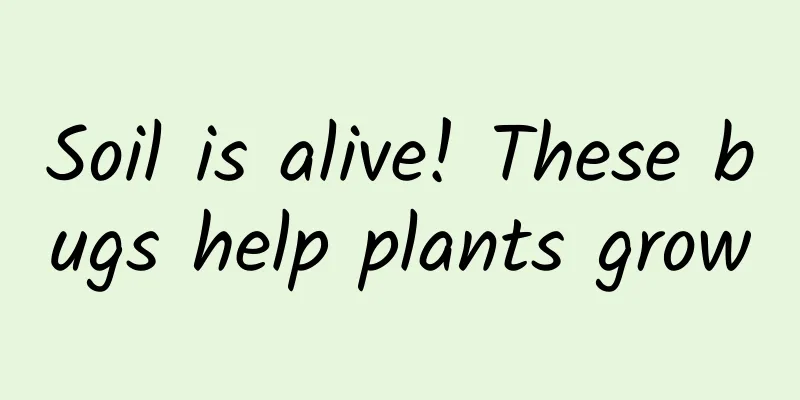Soil is alive! These bugs help plants grow

|
Produced by: Science Popularization China Author: Sun Kuo, Ma Quanhui, Xu Zhenzhu (Institute of Botany, Chinese Academy of Sciences) Producer: China Science Expo Editor's note: In order to decode the latest mysteries of life science, the China Science Popularization Frontier Science Project has launched a series of articles called "New Knowledge of Life" to interpret life phenomena and reveal biological mysteries from a unique perspective. Let us delve into the world of life and explore infinite possibilities. What? The soil is alive! Soil is an important part of the natural environment. The soil under our feet is formed by the weathering of bare rocks and the mixture of decayed life forms. There are hundreds of millions of tiny organisms living in the soil. The number of organisms in 1 gram of healthy soil is more than all the humans on earth (Figure 1). In the soil pores, there is a type of linear invertebrate that moves by water film. They are called "regulators" of plant growth. They are nematodes. The phylum Nematodes is one of the largest phyla in the animal kingdom, with an estimated number of more than one million species, and their numbers are extremely large. They are the most numerous animals on Earth, with millions of them per cubic meter, and the number of them in the global terrestrial surface soil reaches 4.4 × 10²⁰, with a biomass of 300 million tons, which accounts for about 82% of the total human body weight. Figure 1 Soil is alive (Image source: FAO 2020) Various organisms in the soil form a complex network structure through predation relationships, which is called the soil food web (Figure 2). Soil nematodes occupy all trophic levels of the food web, including plant-feeding nematodes, bacteria-feeding nematodes, fungi-feeding nematodes, and predatory-omnivorous nematodes. The different feeding nematodes can generally be distinguished by the type of mouthparts and esophagus (Figure 3). In addition, bacteria-feeding nematodes at low trophic levels tend to be smaller, while predatory nematodes at higher trophic levels are larger (Figure 4). Soil nematodes play a key role in regulating microbial activity, soil nutrient cycling, and plant growth. They are the best indicator of soil health and are "regulators" of plant growth. Figure 2 Soil food web (Image source: FAO 2020) Figure 3 Mouthpart structures of various soil nematodes (ae are bacterivorous, fungivorous, phytophagous, and predatory-omnivorous nematodes) and several Cephalobidae nematodes (gn) (Image source: Reference 2) Figure 4 Soil nematodes under a microscope (20-40 times) (Photo credit: Photo taken by Ma Quanhui) Now, let us enter the microscopic world and learn about the great role of soil nematodes! Soil nematodes are "regulators" of plant growth In the process of plant growth, soil nematodes play a hidden and powerful role. Plant growth requires various nutrients such as nitrogen and phosphorus, and soil nematodes play an important role in the "fertilizer conversion" process. Nematodes feed on various microorganisms in the soil, promote soil nutrient circulation and decomposition of organic matter, improve soil fertility, and thus promote plant growth. At the same time, soil nematodes can promote bacteria to release hormone substances that help plant growth, such as indoleacetic acid and auxin. In addition, some herbivorous nematodes feed on the outer cells of plant roots, slightly stimulating root growth, thereby promoting the expansion and deepening of plant roots and improving the plant's ability to absorb water and nutrients. Figure 5 Soil nematodes are “regulators” of plant growth (Image source: Reference 5) Plant health "underground bodyguard" During the life cycle of a plant, the root system is constantly threatened by pests and diseases. Nematodes help plants resist pests and diseases by preying on pathogens and pests in the soil. For example, insect pathogenic nematodes can find and infect pests that damage plants, thereby reducing the damage caused by pests to plants; bacterial nematodes can directly feed on pathogens that cause plant root diseases, thereby ensuring the healthy growth of plants. At the same time, soil nematodes can stimulate beneficial microorganisms to secrete antagonistic substances, helping plants resist the invasion of pathogens. Therefore, nematodes are like "underground bodyguards" of plants, patrolling around the rhizosphere to protect the healthy growth of plants. However, some plant parasitic nematodes can also cause harm to plants, such as soybean cyst nematodes and root-knot nematodes, which infect the root system of crops and cause a large reduction in grain production. Prevention and control are needed to eliminate these "bad bugs". Figure 6 Soil nematodes protect plants from thriving (Image source: Reference 7) Indicator lights for soil health When soil is degraded or disturbed, the number and structure of soil nematode communities will change, providing us with a tool to monitor soil quality. The diversity, enrichment index and maturity index of soil nematodes can effectively reflect the health of the soil. For example, after over-exploitation of land, the diversity of soil nematodes may decrease and the structure will be simplified, indicating that the function of the soil has declined. This is like the "health indicator light" of the soil has dimmed, reminding us that we need to take measures to improve soil conditions. Figure 7 World Soil Day, protecting soil biodiversity (Photo source: China Green Foundation) Although tiny, soil nematodes are extremely abundant in number and diversity, playing a key role in maintaining soil fertility and regulating plant growth. Soil nematodes are the "secret guardians" of soil health and are an indispensable and valuable resource for the earth. Let us start from now on to pay more attention to and understand soil nematodes, protect soil biodiversity, and build a green home together! References: 1.Bongers, T., & Ferris, H. (1999). Nematode community structure as a bioindicator in environmental monitoring. Trends in Ecology & Evolution, 14(6), 224-228. 2.Ugarte, CM (2009) Soil Nematodes in Organic Farming Systems. https://eorganic.org/node/4495 3.Du Preez, G., Daneel, M., De Goede, R., Du Toit, MJ, Ferris, H., Fourie, H., ... & Schmidt, JH (2022). Nematode-based indices in soil ecology: Application, utility, and future directions. Soil Biology and Biochemistry, 169, 108640. 4.Holovachov, O., De Ley, IT, Mundo-Ocampo, M. & De Ley, P. 2009. Identification of Cephaloboidea Nematoda). EUMAINE, Gent and Nematology, UC Riverside. 86 pp 5.Li, G., Liu, T., Whalen, JK, & Wei, Z. (2023). Nematodes: an overlooked tiny engineer of plant health. Trends in Plant Science, 29(1), 52-63. 6.Van Den Hoogen, J., Geisen, S., Routh, D., Ferris, H., Traunspurger, W., Wardle, DA, ... & Crowther, TW (2019). Soil nematode abundance and functional group composition at a global scale. Nature, 572(7768), 194-198. 7. Wilschut, RA, & Geisen, S. (2021). Nematodes as drivers of plant performance in natural systems. Trends in Plant Science, 26(3), 237-247. |
<<: In the eyes of children, it is "scoring points like crazy" in the deep sea
>>: This rare water bird can even bring its own "spoon" to eat?
Recommend
Analysis report on competitive products of Dewu and Shihuo
This is my first attempt at writing a competitive...
Can black and white color ultrasound still be called color ultrasound?
Produced by: Science Popularization China Author:...
iOS 16.2 finally supports 120Hz high refresh rate!
The day before yesterday, Apple pushed the iOS 1...
What are the equipment for real-name authentication at construction sites?
With the introduction of various national policie...
Enrollment marketing strategy skills for educational institutions!
In 2020, due to the epidemic, the enrollment path...
Android collects nearly 10 times more user data than iOS, report says
Following the Android location tracking scandal, ...
B Station brand marketing strategy!
Is Bilibili still communicating with Generation Z...
With a valuation of $3.7 billion, it may dominate the future development of VR/AR hardware!
There is no doubt that virtual reality/augmented ...
What are the channels for publishing articles for free in soft-text marketing?
Soft content marketing is the most common and eff...
How much does it cost to develop a textile and leather mini program in Shangrao?
There is no doubt that the topic of mini programs...
Recently! My body suddenly became itchy, red and swollen for no apparent reason. Read this article! (It’s not a mosquito)
Who in my family would understand? While waiting ...
How can programmers be respected?
[[129683]] I learned that an old classmate I hadn...
Nezha's fire + Ao Bing's ice = steam explosion?
Review expert: Zhou Hongzhi, senior experimenter ...
Record-breaking! July 21 is the hottest day on record! Next...
Compiled by: Gong Zixin According to data from th...
Opportunities that mini programs will bring in the future, and the future prospects and development of mini programs
Some people say that laziness is the driving forc...









